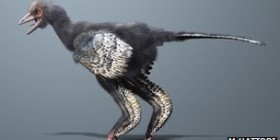Site appears to equal importance of original Burgess Shale discovery
Researchers have discovered a significant new shale fossil bed in Kootenay National Park that could equal the importance and one day even surpass the original discovery of the Burgess Shale in Yoho National Park. The exact location is being kept confidential but it`s near Marble Canyon. Michael Streng and a newly discovered fossil at a new Burgess Shale site near Marble Canyon.

VANCOUVER – An international team of researchers has uncovered a treasure trove of fossils dating back half a billion years in a mountain park in British Columbia — a discovery that could help further explain the evolution of life.
The team from Canada, the United States and Sweden made the discovery in Kootenay National Park, about 200 kilometres west of Calgary, during the summer of 2012. They have just published their findings in the scientific journal Nature Communications.
The discovery is south of Yoho National Park’s 505-million-year-old Burgess Shale, which was discovered more than 100 years ago and has been described as one of the world’s most important fossil sites.
After just two weeks at the Kootenay National Park site, the researchers identified 50 individual species, including about 12 that had never been seen before, which Jean-Bernard Caron hopes is just the beginning.
“Indeed, it was absolutely wonderful, and we found a lot of fossils,” said Caron, a team member and curator at the Royal Ontario Museum. “We were certainly the first human eyes to find them there.”
Caron said the discovery will help researchers better understand the sudden explosion of animal life during the Cambrian Period, which was about 500 million years ago. Back then — about 250 million years before the first dinosaurs — the coastline around Vancouver would have been located in the tropics.
Caron said researchers found mostly invertebrates, animals without a backbone or spinal column, known as arthropods, a group that includes insects, spiders, lobsters, crabs and shrimp. The animals’ eyes, legs and soft tissue, such as gut and gut contents, were preserved, he said.
Caron said some of the species found in Kootenay National Park have also been found in China, which suggests their distribution is wider than previously thought.
The exact location of the fossil beds — in an area Parks Canada describes as “Marble Canyon” — remains confidential to protect the site’s integrity.
Caron said newly discovered Kootenay National Park site and the nearby Burgess Shale site in Yoho are like “sisters,” each telling a complementary story.
He said having access to multiple sites allows researchers to study samples of species that are likely from different time periods. As a result, researchers can get a much better picture about the origins of animals and how they evolved, he said.
Caron said his team plans to return this summer.
“There’s a lot there that the mountain is hiding from us,” he said.
“We certainly hope to find more species at the same location, but also find new sites nearby, and most likely new species (nearby), as well.”
Note to readers: This is a corrected story. A previous version included an incorrect spelling of arthropods.






Leave a reply